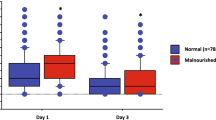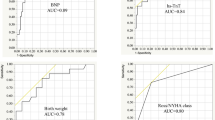Abstract
We sought to examine the role of preoperative and 2nd postoperative day albumin levels as predictors for postoperative course in infants undergoing repair of congenital heart disease. This retrospective, single-center, observational study comprised consecutive infants younger than 1 year who had undergone repair of tetralogy of Fallot, ventricular septal defect, complete atrioventricular canal or transposition of the great arteries over a 25 months period. We correlated preoperative and postoperative day (POD) #2 albumin level to vaso-inotropic score (VIS) and intensive care unit (ICU) length of stay (LOS) as markers for degree and duration of postoperative cardiac support. A composite outcome was defined as maximal vaso-inotropic score of > 10 and ICU LOS > 96 h. Preoperative albumin level negatively correlated with VIS and ICU LOS. Compared to preoperative albumin level of > 4 g/dL, the relative risk of meeting composite criteria was 1.5 for preoperative albumin of 3.1–4 g/dL and 2.6 for preoperative albumin ≤ 3 g/dL. Compared to POD#2 albumin level > 3 g/dL, the relative risk of meeting composite criteria was 1.8 for albumin of 2.6–3 g/dL, and 2.5 for albumin ≤ 2.5 g/dL. In summary, we found that preoperative and POD#2 albumin levels predicted prolonged and complicated postoperative course. These finding may help clinicians to inform the patient’s parents, early in the ICU hospitalization, as to the predicted risks and difficulties of their infant’s postoperative course.





Similar content being viewed by others
References
Horowitz IN, Tai K (2007) Hypoalbuminemia in critically ill children. Arch Pediatr Adolesc Med 161:1048–1052
Ballmer PE (2001) Causes and mechanisms of hypoalbuminaemia. Clin Nutr 20:271–273
Montisci A, Miceli A (2017) A new weapon in the fight against postcardiac surgery muscle catabolism. J Thorac Cardiovasc Surg 153:379–380
Henry BM, Borasino S, Ortmann L, Figueroa M, Rahman AKMF, Hock KM, Briceno-Medina M, Alten JA (2019) Perioperative serum albumin and its influence on clinical outcomes in neonates and infants undergoing cardiac surgery with cardiopulmonary bypass: a multi-centre retrospective study. Cardiol Young 29:761–767
Durward A, Mayer A, Skellett S, Taylor D, Hanna S, Tibby SM, Murdoch IA (2003) Hypoalbuminaemia in critically ill children: incidence, prognosis, and influence on the anion gap. Arch Dis Child 88:419–422
Leite HP, Fisberg M, De Carvalho WB, de Camargo Carvalho AC (2005) Serum albumin and clinical outcome in pediatric cardiac surgery. Nutrition 21:553–558
Rich MW, Keller AJ, Schechtman KB, Marshall WG Jr, Kouchoukos NT (1989) Increased complications and prolonged hospital stay in elderly cardiac surgical patients with low serum albumin. Am J Cardiol 63:714–718
Engelman DT, Adams DH, Byrne JG, Aranki SF, Collins JJ Jr, Couper GS, Allred EN, Cohn LH, Rizzo RJ (1999) Impact of body mass index and albumin on morbidity and mortality after cardiac surgery. J Thorac Cardiovasc Surg 118:866–873
de la Cruz KI, Bakaeen FG, Li Wang X, Huh J, LeMaire SA, Coeslli JS, Chu D (2011) Hypoalbuminemia and long-term survival after coronary artery bypass: a propensity score analysis. Ann Thorac Surg 91:671–675
Lee EH, Chin JH, Choi DK, Hwang BY, Choo SJ, Song JG, Kim TY, Choi IC (2011) Postoperative hypoalbuminemia is associated with outcome in patients undergoing off-pump coronary artery bypass graft surgery. J Cardiothorac Vasc Anesth 25:462–468
Van Beek DEC, Van Der Horst ICC, De Geus AF, Mariani MA, Scheeren TWL (2018) Albumin, a marker for post-operative myocardial damage in cardiac surgery. J Crit Care 47:55–60
Go PH, Hodari A, Nemeh HW, Borji J, Lanfear DE, Williams CT, Paone G, Morgan JA (2015) Effect of preoperative albumin levels on outcomes in patients undergoing left ventricular device implantation. ASAIO J 61:734–737
Hsu RB (2007) Heart transplantation in patients with end-stage heart failure and cardiac. Circ J 71:1744–1748
Husain F, Jeong IH, Spight D, Wolfe B, Mattar SG (2018) Risk factors for early postoperative complications after bariatric surgery. Ann Surg Treat Res 95:100–110
Nelson CL, Kamath AF, Elkassabany NM, Guo Z, Liu J (2019) The serum albumin threshold for increased perioperative complications after total hip arthroplasty is 3.0 g/dL. HIP Int 29:166–171
Kudsk KA, Tolley EA, DeWitt RC, Janu PG, Blackwell AP, Yeary S, King BK (2003) Preoperative albumin and surgical site identify surgical risk for major postoperative complications. J Parenter Enter Nutr 27:1–9
Leite HP, Rodrigues da Silva AV, de Oliveira Iglesias SB, Koch Nogueria PC (2016) Serum albumin is an independent predictor of clinical outcomes in critically ill children. Pediatr Crit Care Med 17:e50–e57
Singhi S, Tiwari LK, Jayashree M, Baranwal AK, Bansal A (2014) Hypoalbuminemia in critically sick children. Indian J Crit Care Med 18:565–569
Kittisakmontri K, Reungrongrat S, Lao-Araya M (2016) Hypoalbuminaemia at admission predicts the poor outcomes in critically ill children. Anaesthesiol Intensive Ther 48:158–161
Radman M, Mack R, Barnoya J, Castañeda A, Rosales M, Azakie A, Mehta N, Keller R, Datar S, Oishi P, Fineman J (2014) The effect of preoperative nutritional status on postoperative outcomes in children undergoing surgery for congenital heart defects in San Francisco (UCSF) and Guatemala City (UNICAR). J Thorac Cardiovasc Surg 147:442–450
Ong C, Han WM, Wong JJ, Lee JH (2014) Nutrition biomarkers and clinical outcomes in critically ill children: a critical appraisal of the literature. Clin Nutr 33(2):191–197
Davari P, Tabib A, Ghaderian M, Givtaj N (2009) Correlation of post-operative hypoalbuminemia with outcome of pediatric cardiac surgery. J Tehran Univ Heart Center 4:234–239
Castleberry C, White-Williams C, Naftel D et al (2014) Hypoalbuminemia and poor growth predict worse outcomes in pediatric heart transplant recipients. Pediatr Transplant 18:280–287
Jenkins KJ, Gauvreau K, Newburger JW, Spray TL, Holler JH, Iezzoni LI (2002) Consensus-based method for risk adjustment for surgery for congenital heart disease. J Thorac Cardiovasc Surg 123:110–118
Shenkin A, Cederblad G, Elia M, Isaksson B (1996) Laboratory assessment of protein energy status. J Int Fed Clin Chim 8:58–61
Gaies MG, Gurney JG, Yen AH et al (2010) Vasoactive-inotropic score as a predictor of morbidity and mortality in infants after cardiopulmonary bypass. Pediatr Crit Care Med 11:234–238
Kim JW, Gwak M, Shin WJ, Kim HJ, Yu JJ, Park PH (2015) Preoperative factors as a predictor for early postoperative outcomes after repair of congenital transposition of the great arteries. Pediatr Cardiol 36:537–542
Leite HP, Fisberg M, Novo NF, Nogueira EB, Ueda IK (1995) Nutritional assessment and surgical risk makers in children submitted to cardiac surgery. Sao Paulo Med J 113:706–714
Kapoor PM, Narula J, Chowdhury UK, Kiran U, Taneja S (2016) Serum albumin perturbations in cyanotics after cardiac surgery: patterns and predictions. Ann Card Anaesth 19:300–305
Ootaki Y, Yamaguchi M, Oshima Y, Yoshimura N, Oka S (2002) Effects of modified ultrafiltration on coagulation factors in pediatric cardiac surgery. Surg Today 32(3):203–206
Author information
Authors and Affiliations
Corresponding author
Ethics declarations
Conflict of interest
The authors declare that they have no conflicts of interest.
Ethical Approval
This study was approved the local institutional review board. Parental/legal guardian informed consent was waived.
Additional information
Publisher's Note
Springer Nature remains neutral with regard to jurisdictional claims in published maps and institutional affiliations.
Rights and permissions
About this article
Cite this article
Schiller, O., Goldshmid, O., Mowassi, S. et al. The Utility of Albumin Level as a Marker of Postoperative Course in Infants Undergoing Repair of Congenital Heart Disease. Pediatr Cardiol 41, 939–946 (2020). https://doi.org/10.1007/s00246-020-02339-6
Received:
Accepted:
Published:
Issue Date:
DOI: https://doi.org/10.1007/s00246-020-02339-6




